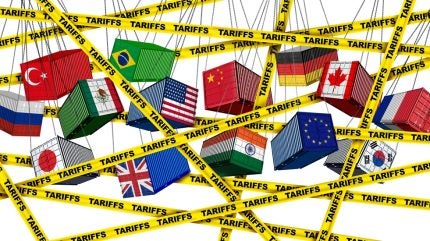
Tariffs are reshaping the global packaging industry under President Donald Trump’s second term, with a universal 10% import duty now in force alongside higher steel and aluminium tariffs.
These measures, coupled with foreign retaliation, are raising packaging costs, complicating material sourcing and fuelling supply chain uncertainty for cans, foils, cartons and plastics.
Analysts estimate the 2025 tariff wave is weighing on US growth and trade, with knock-on effects for packaging demand worldwide.
Tariffs lift input costs and unsettle supply chains
The White House restored and expanded Section 232 metals duties in early 2025 and later imposed a 10% “baseline” tariff on all imports, with higher reciprocal rates for key trading partners.
Aluminium and steel used in beverage cans, closures and foils now attract steeper duties, a shift already filtering through to pack prices and procurement strategies.
Packaging buyers report “front-loading” of orders to beat tariff start dates, followed by a scramble to qualify alternative suppliers—behaviour that adds warehousing costs and makes landed prices volatile.

US Tariffs are shifting - will you react or anticipate?
Don’t let policy changes catch you off guard. Stay proactive with real-time data and expert analysis.
By GlobalDataInvestment banks and policy labs say the current tariff settings, plus retaliation, are reducing exports and slowing growth, raising the risk of broader price pressures in grocery and household goods.
Retaliation has intensified the squeeze. China filed a WTO case and enacted countermeasures after new US tariff rounds, while rare-earth export controls and other trade frictions add risk to machinery, inks and electronics in smart packaging.
Banks have flagged higher recession odds as tariff coverage widened in 2025.
Deregulation shifts environmental and labelling rules
In parallel, Washington has moved to unwind multiple federal environmental rules.
The US Environmental Protection Agency proposed rolling back power-sector greenhouse gas limits and reconsidering other climate policies, part of a wider deregulatory push affecting energy and manufacturing.
For packaging, looser federal oversight may trim some compliance costs but increases policy divergence with states and international markets that are tightening rules on recyclability, plastics and emissions.
Food and consumer-goods labelling is also in flux. FDA updated inspection guidance for labelling compliance and proposed scrapping several dated standards of identity—changes that could alter pack copy, artwork cycles and import checks.
Brands exporting to the US should track these shifts alongside state-level requirements to avoid reprint and relabelling costs.
What it means for prices, investment and sustainability
For aluminium beverage and food cans, higher import duties are pushing up input costs and could steer some volume back to plastic bottles where life-cycle costs are lower—an outcome major drinks companies have publicly contemplated.
That dynamic collides with brand pledges on recyclability and recycled content, since metals are among the most readily recyclable packaging substrates.
Across substrates, tariff-driven uncertainty is influencing capital spending. Converters weighing new US capacity may welcome domestic-production incentives and firmer pricing, yet prolonged trade frictions typically dampen demand visibility and raise equipment and resin costs.
Independent assessments this autumn estimate the tariff regime and retaliation are shaving roughly half a percentage point from US growth in 2025–26, which could soften volumes for transport packaging and discretionary consumer packs.
For global packaging managers, the immediate priorities are clear: diversify sourcing for steel, aluminium, paper and resins; model scenarios for universal and partner-specific tariffs; and align sustainability roadmaps with divergent US federal and state rules and tighter requirements in Europe and Asia.
In short, deregulation may ease some compliance burdens, but the dominant 2025 story for the packaging industry is cost inflation and planning uncertainty stemming from expansive US tariffs and the reactions they have triggered.
Navigate the shifting tariff landscape with real-time data and market-leading analysis. Request a free demo for GlobalData’s Strategic Intelligence here.





